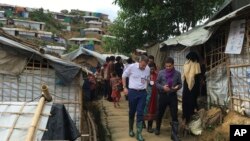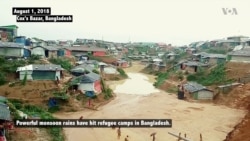The Rohingya minority members who fled a military campaign in Myanmar to neighboring Bangladesh are now faced with the growing threat of heavy rains that have hammered refugee camps for weeks.
Officials in the southeastern coastal town of Cox's Bazar told VOA they have moved about 40,000 Rohingya refugees from high-risk camps to safe shelters and plan to evacuate more as the monsoon floods continue.
Heavy rains force evacuations
Md Nikaruzzaman Chowdhury, the chief executive of Ukhia subdistrict, told VOA that the 200,000 refugees who settled on muddy hills of the Kutupalong refugee camp were most affected by the intensity and speed of the rain.
“The government and humanitarian agencies have already identified the Rohingyas who live on hills to evacuate them soon,” said Chowdhury.
“Kutupalong is a hilly area with a fragile soil. It was a deep forest before, but we cut down the trees to make room for refugees. We discussed the vulnerability of Kutupalong to landslides with the local government and NGOs before the rain season, and have been working to address the issue since then,” Chowdhury said.
He said the refugee camps consisted of rudimentary tarpaulin-and-bamboo shanties, making them easily vulnerable to monsoon rains.
Cox’s Bazar officials say their town recorded over 500 millimeters (20 inches) of rainfall last week, with Kutupalong receiving nearly 350 millimeters (14 inches) in 24 hours last Wednesday.
WATCH: Monsoon Rains Threaten Thousands
Landslide causes damage to shelters
Last week, authorities reported five deaths in nearby communities, including one child.
Md Ali Kabir, the divisional forest officer for Cox’s Bazar South Forest, said a landslide earlier this week in one Kutupalong hill camp demolished at least five shelters and damaged 30 more. No casualties were recorded from the incident.
He estimated at least 600 settlements were affected and 500 Rohingya people were injured from landslides across Kutupalong.
Refugees who were evacuated from the hill camps told VOA the new shelters provided them safety from the storms, but they reported shortages of basic services.
Lack of utensils
Shamsul Alam, a refugee, said he and his family were given food supplies but that the new Kutupalong extension camps lacked utensils.
“We get rice here but not any facility to cook it,” said Alam, adding most refugees were tired of being moved to different camps.
“I feel I am in a kind of prison where life is very uncertain and does not point to any kind of light or hope,” he said.
Rights organizations warned that stagnant water from rainfall has also increased the risk of infectious diseases, particularly cholera among children.
WATCH: Aid and Rights Organizations Worried About Rohingya
'We are not doing enough'
Saikat Biswas, the spokesperson for the Inter Sector Coordination Group, told VOA that international organizations are trying to provide urgent aid for the affected people but cannot properly care for such a large concentration of Muslim Rohingya.
“We know that we are not doing enough. We are failing to provide the basic needs,” said Biswas.
He said members of the minority group should ultimately be allowed to safely return to Myanmar in order to end their suffering.
The Rohingya represent the largest percentage of Muslims in Myanmar, with the majority living in the west coast state of Rakhine. Their population was estimated to be around 1 million at the beginning of 2017, but the United Nations says nearly 1 million have fled into neighboring Bangladesh because of a brutal crackdown by Myanmar’s army, which claimed it was targeting terrorists.










